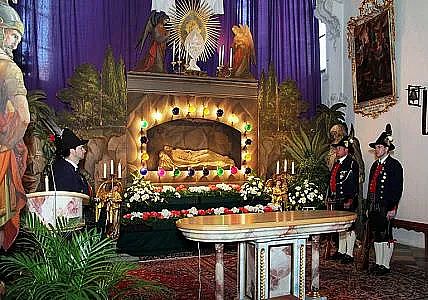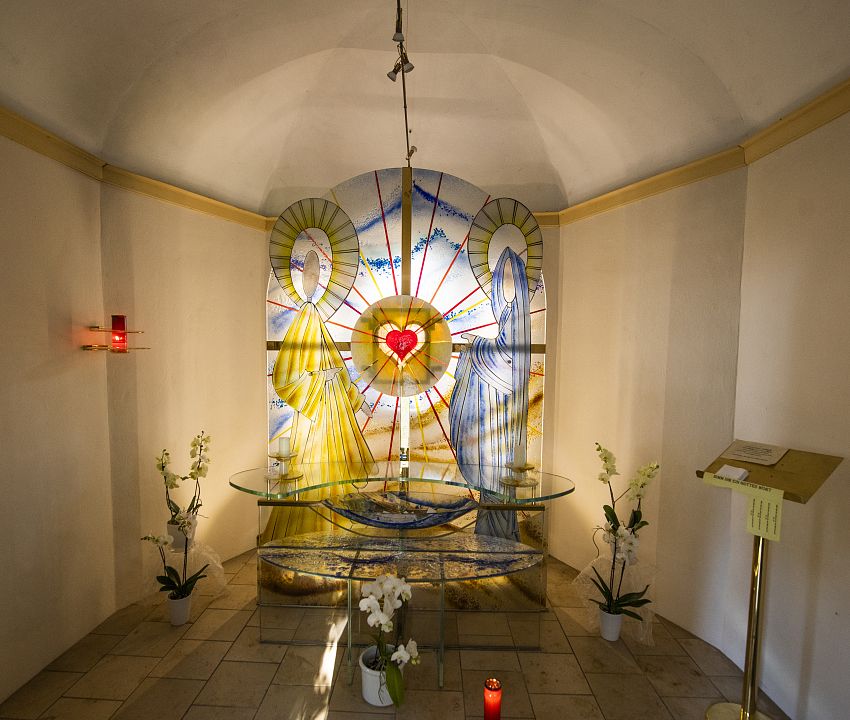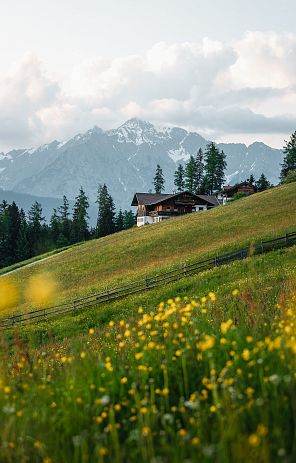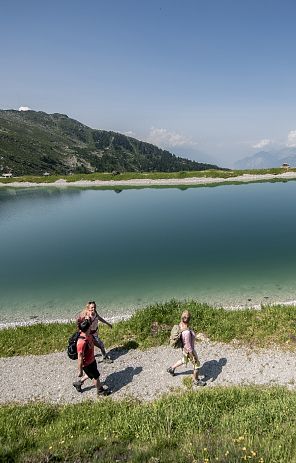Powerful Place. Basilica of St. Mary in Absam
Absam owes its importance as a place of pilgrimage known far beyond Tyrol to the miraculous image of Our Lady, which appeared on the window pane of a house in Absam on January 17, 1797. The pilgrimage church is a real art-historical treasure on the outside, but especially on the inside, which tells a long story. St. Mary's Square and St. Mary's Chapel as well as the sacristan's house and the votive tablet chapel round off this wonderful ensemble.
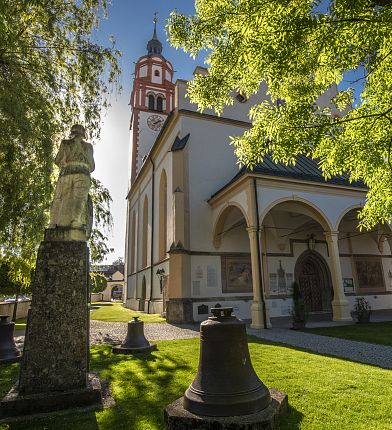
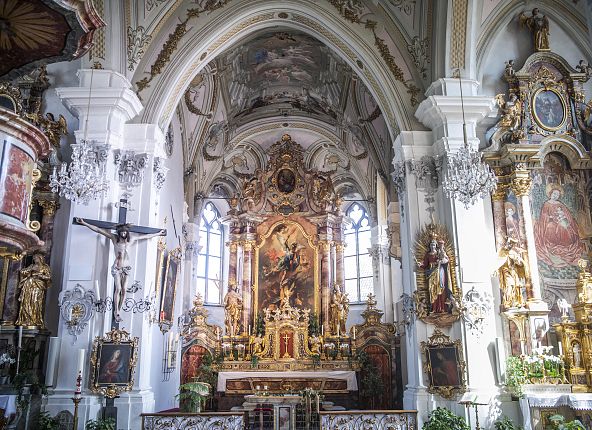
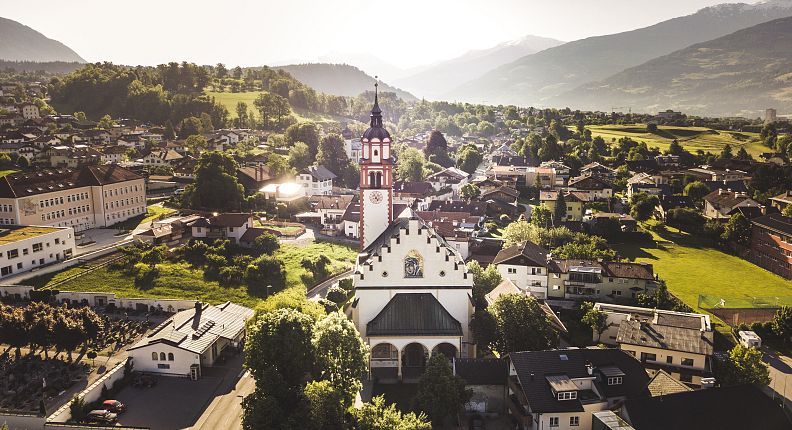
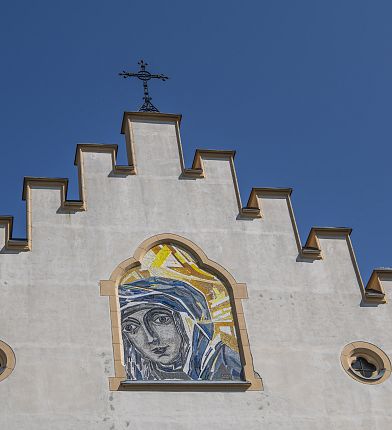
The power place Marienbasilika Absam at a glance
- Image of Mary
- most important place of pilgrimage in Tyrol
- Votive tablets
- Monthly pilgrimage: every first Sunday of the month
- Souvenirshop
- popular wedding church in Tyrol
Origin of the parish church of St. Michael
Centuries before this significant event, Absam already had a church dedicated to St. Michael the Archangel. Around 1280, it was elevated to an independent parish under the patronage of the Bishop of Augsburg. The reason for this was the brisk population growth when salt began to be mined in the Halltal valley in the first half of the 13th century. The parish church was first mentioned in a document in 1331, together with the subsidiary churches of St. Nicholas in Hall and St. Ulrich in Thaur.
However, the parish church of Hall was very quickly regarded as a larger and more important parish, as more and more salt workers settled in Hall with the construction of the brewhouse on the banks of the Inn, the fortification of the town and the granting of the town charter in 1303. The population soon exceeded that of Absam and the parish of Hall soon outstripped that of Absam. This sealed the fate of Absam as the seat of the parish in favor of the town for centuries. It is safe to assume that the parish priest resided in the town of Hall from around 1339/1340. Apart from the residence of the clergy, there were also efforts to transfer parish rights from Absam to Hall. In order to maintain the connection between Hall and Absam and to ensure that the true ecclesiastical relationships were not forgotten, the clergy and the citizens of Hall were obliged to hold an annual procession to Absam on the Sunday after St. Vitus' Day (June 15) and on St. Michael's Day (September 29) as the patron saint of Absam church.
The church's predecessor, including the Widum, was destroyed by Bavarian troops in 1413. According to archival research, the new building of today's church was constructed around the middle of the 15th century and was modeled on the Hall parish church as a late Gothic hall church. As a result of earthquake damage, numerous alterations were necessary over the centuries, which mainly affected the design of the tower. The baroque interior was renovated in 1779/80 and the façade was restored in 1897/98 on the occasion of the 100th anniversary of the apparition of the miraculous image: the striking stepped gable and the porch were added. The interior of the church was restored in 1976/77 and the exterior in 1988/89.
The furnishings of St. Mary's Basilica Absam
The pilgrimage church is a real art-historical treasure on the outside, but especially on the inside, with a long history to tell. Here is an excerpt of the most interesting and important details of the church:
The west façade with its stepped gable defines the townscape of Absam. Beneath it is a mosaic of the Absamer Gnadenmutter by the Storch Mosaik company from Zirl. Above the pointed arched main portal is a ceramic papal coat of arms made by Absam artist Werner Richter in 2000. It identifies the church as a basilica.
The ceiling painting by Josef Anton Zoller in the basilica depicts the glory of God the Father and St. Michael (patron saint of the church). Above the organ loft in the west, the church founders venerate St. Rupert and St. Magdalena as protectors of the village of Absam. Among other things, St. Rupert is the patron saint of salt mining. Depicted on a cloud with the bishop's insignia of mitre and crozier, a salt skid can also be seen. A view of Absam shows not only the village with the church and the Krippach and Melans residences, but also the manor houses and the Thaurer Romedikirchl church.
The high altarpiece from the middle of the 18th century is dedicated to the church's patron saint, St. Michael the Archangel. He is dressed in blue armor and a red cloak and is busy pushing the fallen angels into the depths with the flaming sword in his right hand. It was probably painted by Franz Sebald Unterberger (1706-1776).
The southern side altar is also the altar of grace, which became the actual center of the pilgrimage church when the image of grace was transferred to the parish church in 1797. In 1894, the altar was decorated with a neo-baroque three-part tabernacle structure to accommodate the Absam image of grace. The picture of grace itself is framed by a splendid gilded frame, richly decorated with various votive ornaments from the local population.
The crucifix on the northern wall of the triumphal arch, the so-called "Fiegerkreuz", is a particularly interesting work of art that is revered by the locals. It is carved from Swiss stone pine and was made by an Inntal master from the second half of the 15th century. The polychrome Fieger coat of arms is applied to the high cross beam and the year "1492" is carved underneath. Hans Fieger von Melans is a possible donor.
The baptismal font made of white marble by Franz Gartner from Laas in South Tyrol is located at the western end of the northern aisle and dates from 1885. It has reliefs on the basin walls: Evangelist symbols, baptism of Christ, doves. The wooden lid has the shape of an octagonal pyramid in neo-Gothic forms.
Absam becomes a pilgrimage church - the miraculous image
At the end of the 18th century, the parish of Absam experienced an enormous upswing and developed into an important place of pilgrimage in the region. The reason for this was the apparition of Mother Mary on a window pane of a farm near the church.
On January 17, 1797, 18-year-old Rosina Bucher was sitting in the parlor of her parents' house and saw a portrait of a woman in a window pane in the light of the setting sun. A few days passed, however, during which the Bucher family kept quiet. It was only when the school teacher found out about it and made it public that people began to talk about a Marian apparition, especially because of the oriental nature of the headscarf. Word of the apparition spread quickly and a short time later many people from Absam and the surrounding villages gathered to see the apparition of the Virgin Mary. A contemporary report stated:
"This image consists only in the head surrounded by a stuchen (= headscarf). Rays of light are visibly indicated above it. She is leaning to the right. Is not designed with color, but the shading consists in a dullness, almost like stale panes have in themselves. By touching it, one cannot be sure whether the cloudy glass is rougher than the bright glass". The report also notes that the image can be seen under all external circumstances. Only if the glass is wiped on both sides with a wet sponge does the image disappear, but when the glass dries, the image reappears.
The number of worshippers increased so much that the episcopal ordinariate felt compelled to investigate the matter further. The glass was taken to the dean in Innsbruck, and on February 21, 1797, it was examined by a commission. All methods to make the image disappear failed, but the commission also found no evidence of a miracle and was therefore not classified as such. Based on an article in the "Boten für Tirol und Vorarlberg" from 1878, it can be assumed that there were other disks in the area with etched images of pious content, without these being considered miraculous phenomena. The messenger reports that 300 years ago there were already pictures with etched drawings in the royal monastery in Hall and the Jesuit college of the time. The paint applied to the back could have faded or been washed away over the years. In any case, this explanation is probably much closer to the actual origin of the painting of the Virgin Mary and also corresponds to the findings of the episcopal commission of 1797.
Soon after the investigation, the dean returned the image under pressure from the population, and a separate chapel was even to be erected, although the Bishop of Brixen forbade this in a letter dated August 21, 1797. However, the reaction of the population had been underestimated. As early as June 1797, the first devotional pictures printed in Wilten without the church's permission were confiscated. A further 300 pictures were confiscated at the Hall market.
During a procession on June 24, 1797, the picture was brought into the church in a solemn procession and hung at the high altar. When the bishop heard about this, he ordered the picture to be removed immediately and at best hung on a side wall of the church. However, the people of Absam hung it on the right side altar. Pilgrimages to the Absam image of grace quickly developed, despite being forbidden by the bishop. Fourteen votive tablets from 1797 alone bear witness to the fact that veneration had already grown in the first year. This was not least due to the fact that the success of Spinges, where a Tyrolean victory was achieved on April 2, 1797 during the Napoleonic Wars, was attributed to the intercession of the Virgin Mary. 1799 finally saw the first peak in the veneration of the miraculous image and pilgrimages to Absam. The marksmen also repeatedly organized pilgrimages to Absam, a custom that has continued to this day.
Although the miraculous image was not regarded as a miraculous phenomenon by either the official church or the state, it developed a momentum of its own that could no longer be stopped. Since then, two processions have been held in Absam every year, one on January 17th, the day of the alleged apparition of the image, and the other on June 24th, the day the image was transferred to the church.
Two imperial medals from 1848 prove that members of the Austrian imperial family also made pilgrimages to Absam.
Although never officially confirmed by the church and even banned by the state at times (1938-1945), the Absam miraculous image and the associated pilgrimages have not lost their significance to this day. The "prayer book", which has been available since 1986, now contains many thousands of entries. In addition, the church in Absam has been a popular marriage church for Tyroleans since 1797.
The monthly pilgrimage takes place on the first Sunday of every month at 2.00 pm, beginning with the rosary and followed by a blessing of the sick.
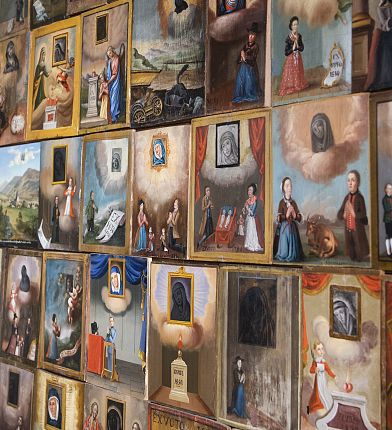
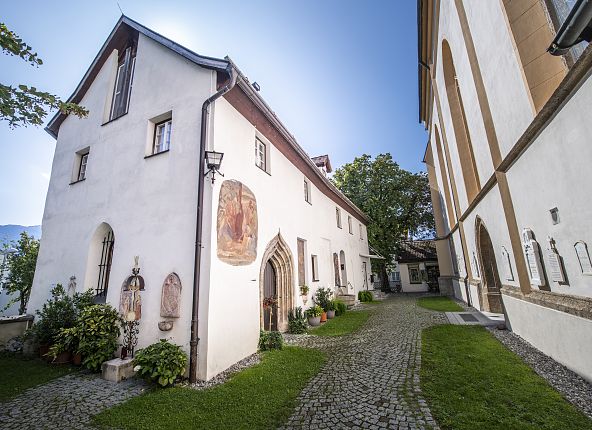
The pilgrimage church in Absam becomes a basilica
On June 24, 2000, the church in Absam received an extraordinary distinction. It was the only church in Tyrol not connected to a monastery or convent to be elevated to basilica status. This was in recognition of the fact that Absam is the most important Marian pilgrimage site in Tyrol. The esteem in which the pilgrimage church in Absam was held can best be seen from the entry in the "Lexikon für Theologie und Kirche":
"Apart from a number of main Roman churches and older cathedrals (Worms, Speyer, Bamberg), it is mainly pilgrimage churches (including Lourdes, Fatima, Altötting, Mariazell) and outstanding monastery churches that have received this distinction in more recent times."
The Easter tomb in St. Mary's Basilica Absam
Marienplatz and Marienkapelle
The votive tablet chapel and the sacristan's house at St. Mary's Basilica in Absam
The votive tablet chapel
Located opposite the sacristy in the eastern part of the sacristan's house, the chapel is entered on its north side through a late Gothic ogee arch portal from the 16th century with multiple profiled and grooved jambs and intersecting bars. The simple hall-like room contains a baroque altar with a crucifixion group and was redesigned around 1800 and decorated with a ceiling fresco by Alois Posch (1776-1807). This fresco in a stucco frame depicts the resurrection of Christ and cartouches with grisailles in the corners of the picture: Lamb of God, Death in the form of a skeleton with an hourglass, Last Judgement, Hell. On the south wall, to the side of the altar, are the painted figures of St. Barbara and St. Joseph.
The chapel is particularly special because of the more than 400 votive tablets kept there. The votive tablets and the "prayer book", which can be found in the church, vividly tell of the many requests and petitions of the faithful (illnesses, spiritual needs, etc.) who make pilgrimages here.
The simple prayer benches are remnants of the seating from 1784 that was removed from the parish church in 1930.
The sacristan's house
The sacristan's house is located to the south of the parish church, integrated into the cemetery wall. It dates back to the 15th century and is a single-storey building or three-storey on the south side due to the hillside location. The building has a crippled hipped roof, an irregular façade structure and remarkable Gothic architectural details on the exterior and interior. The north façade is adorned by a fountain with a ceramic relief of St. Michael by Karl Obleitner.
